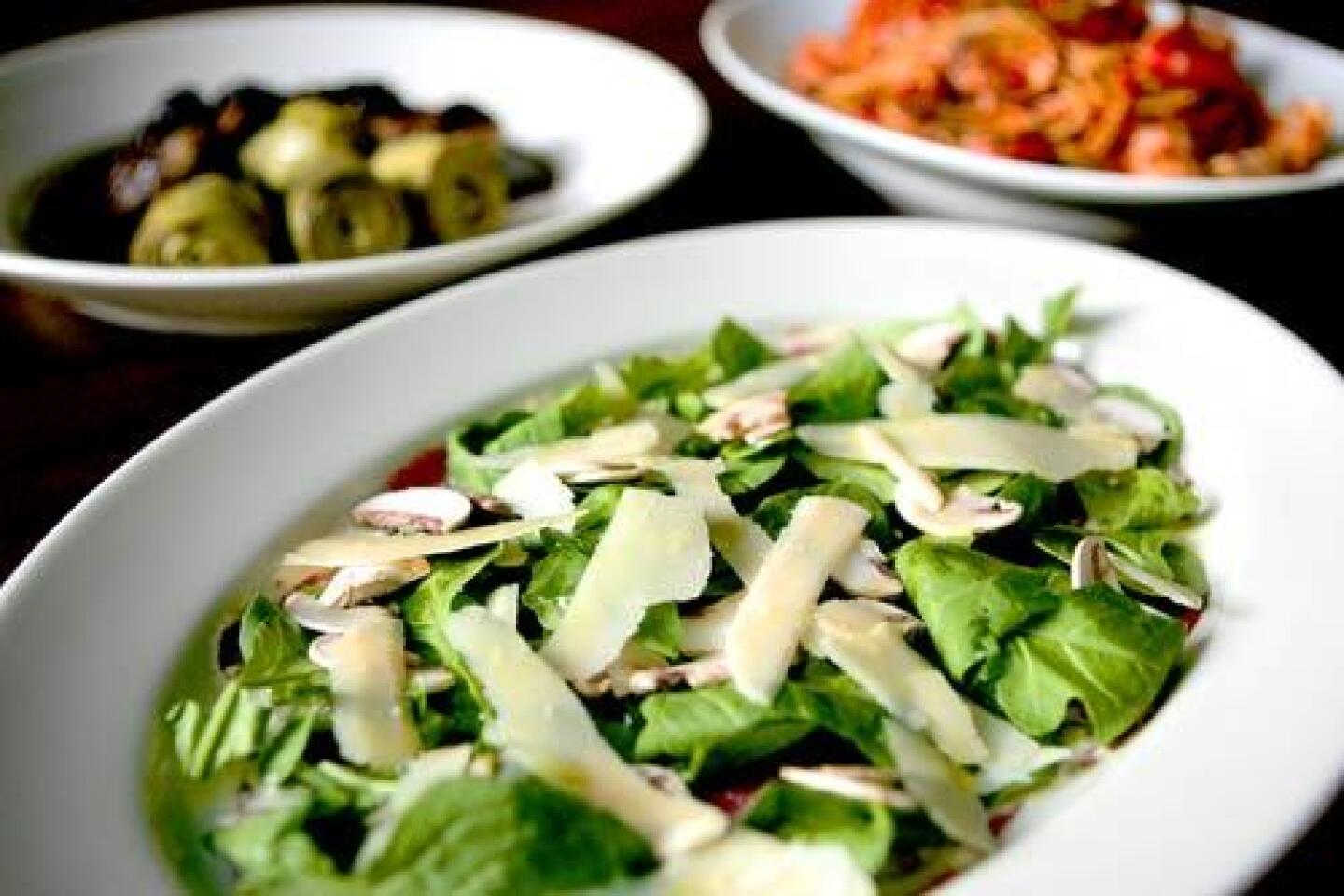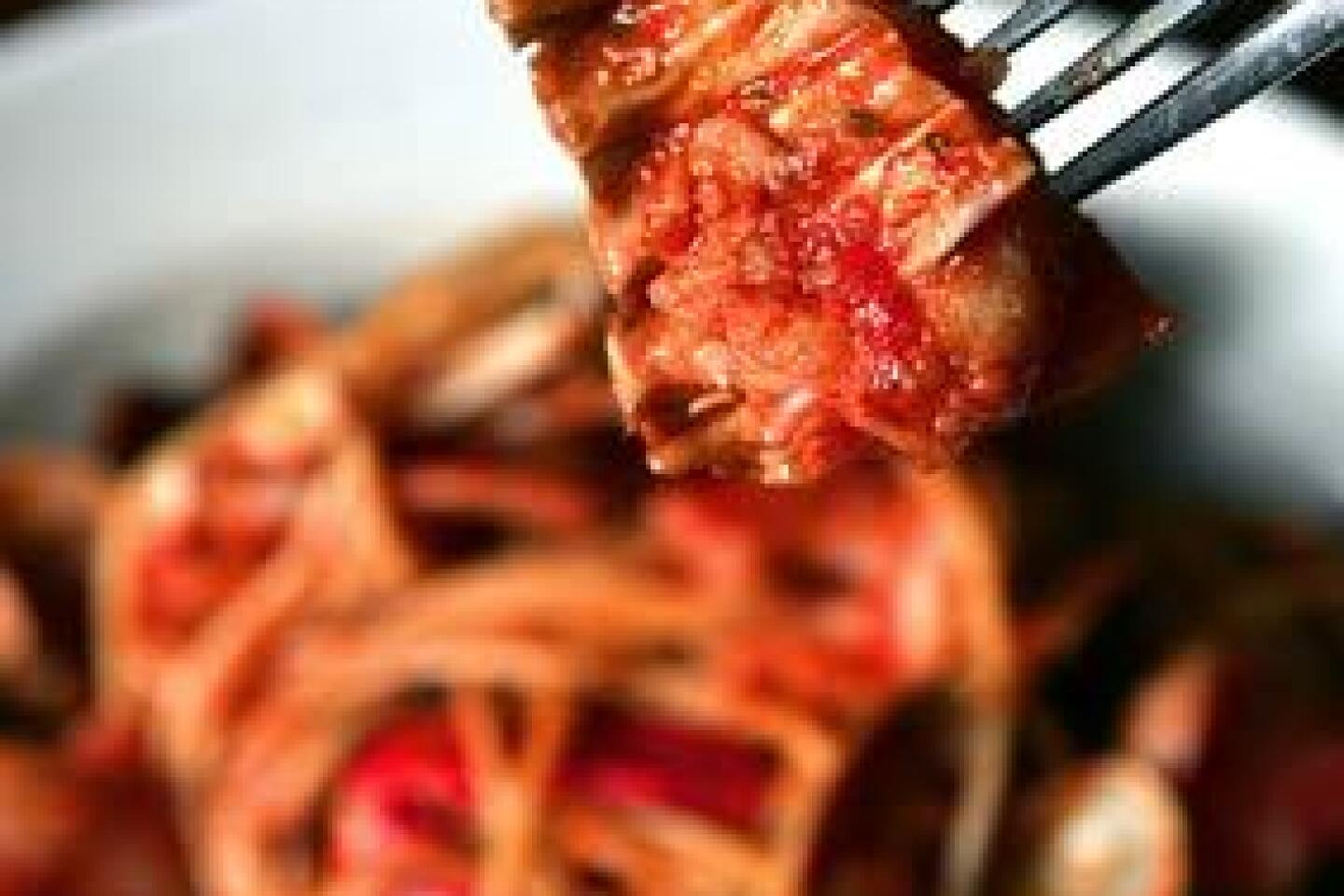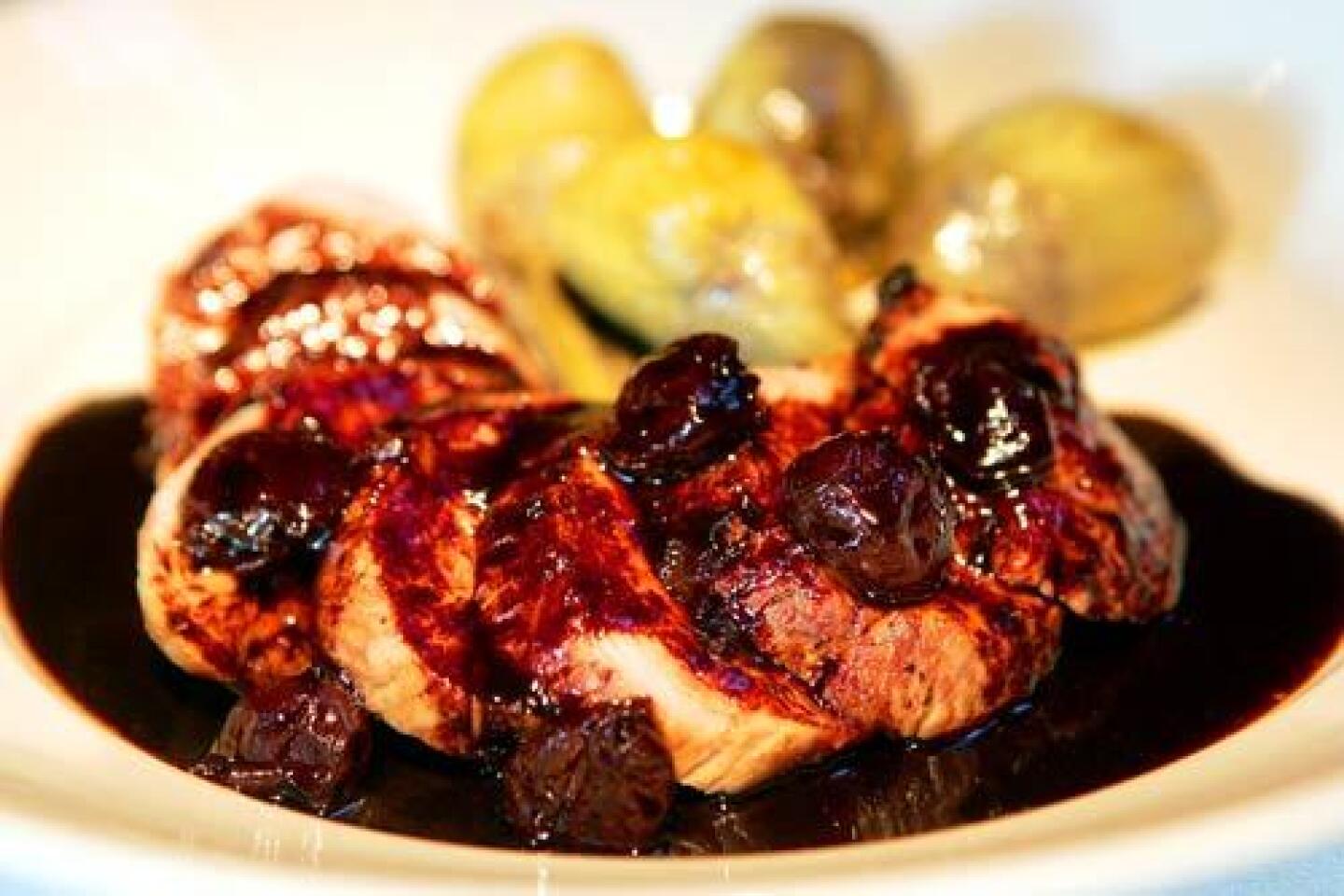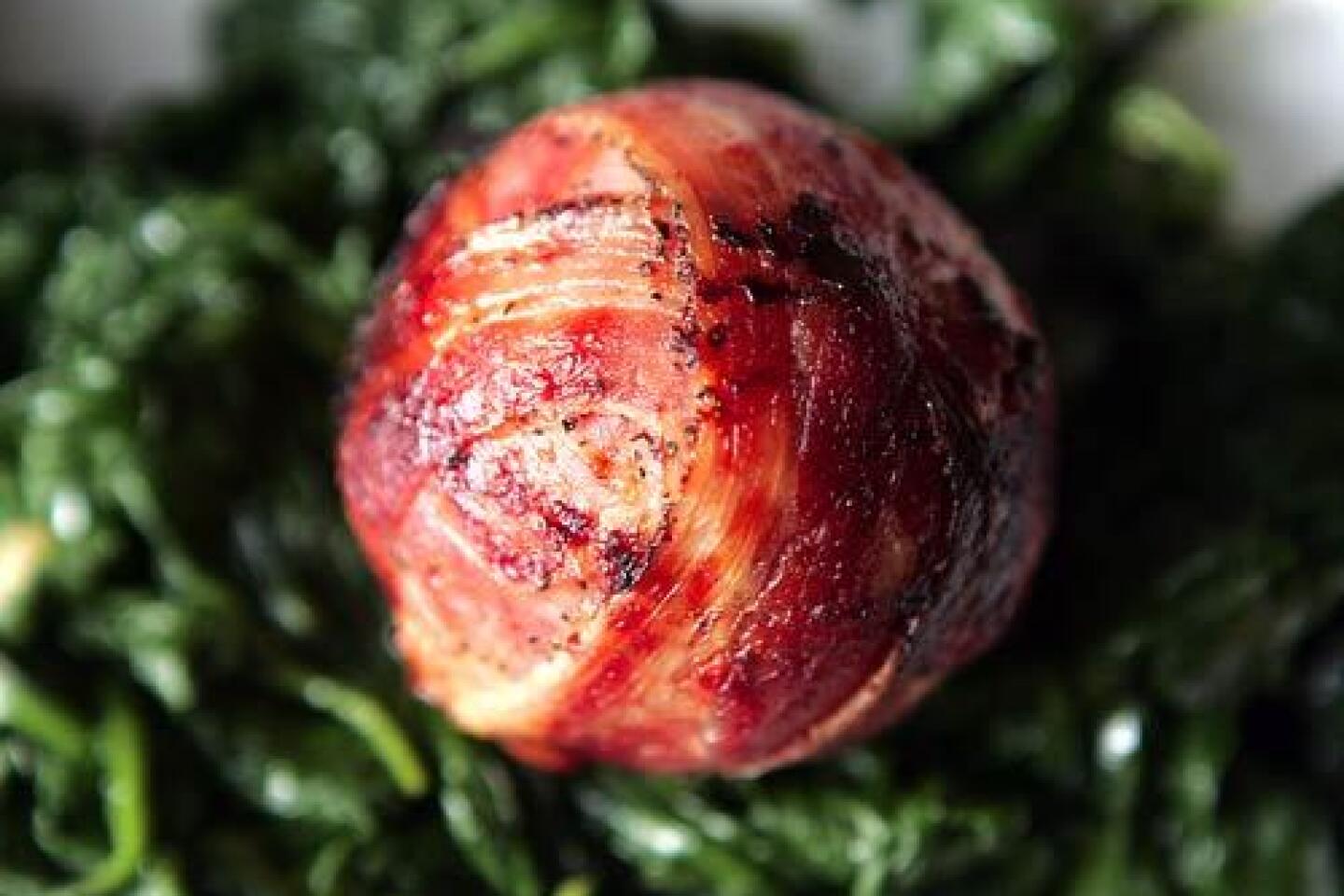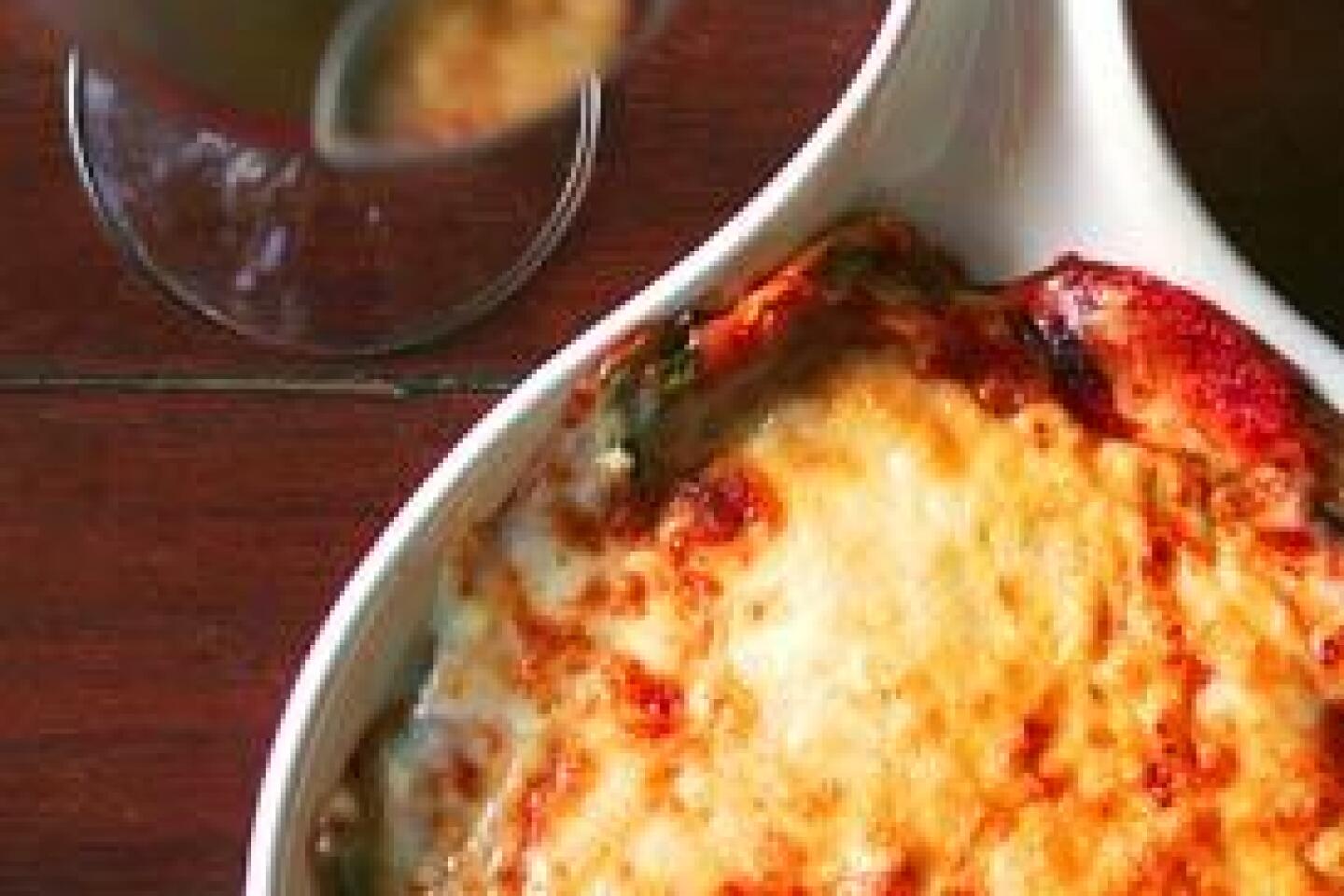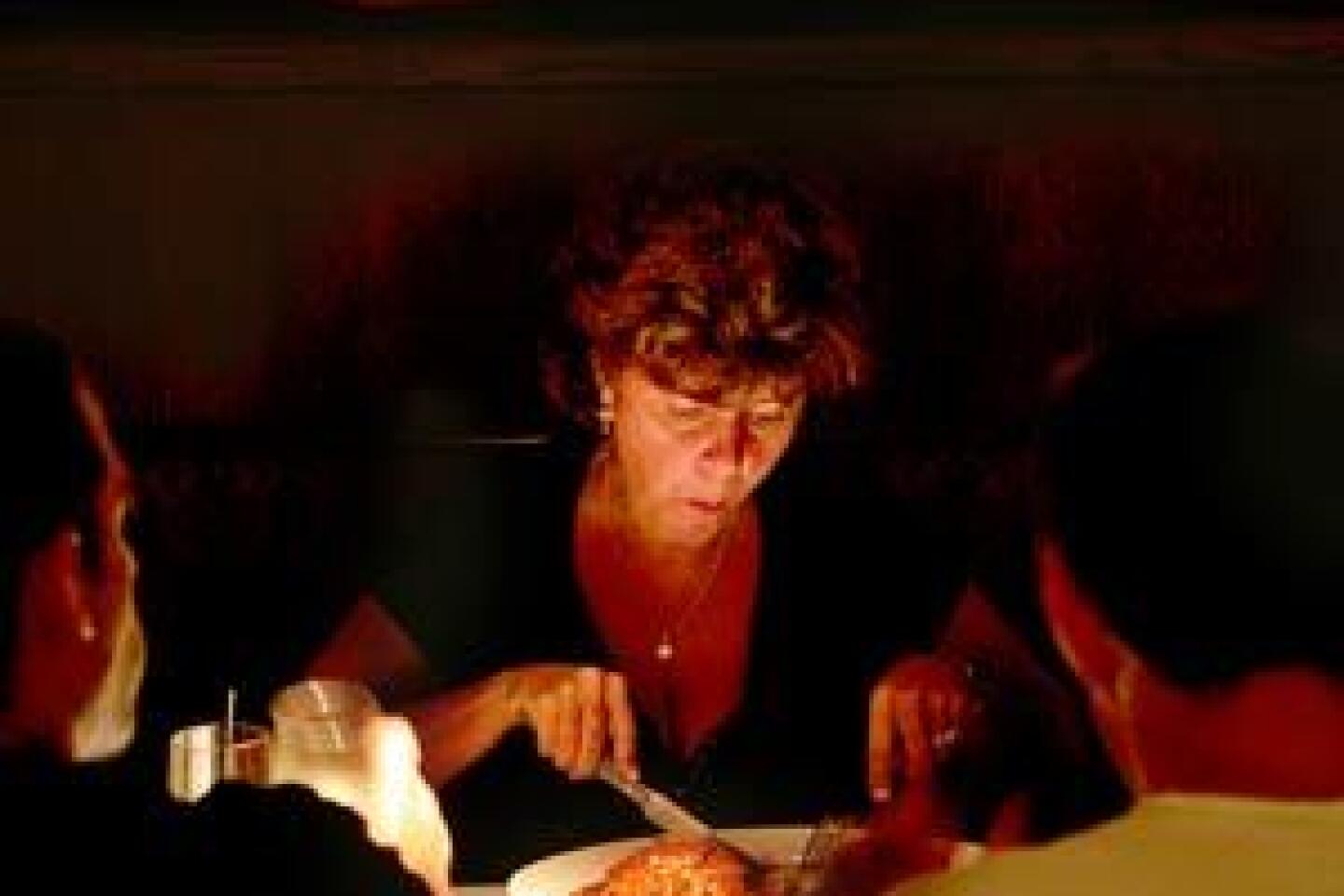Caâ Brea reopens, tries to revive its allure
Caâ Brea is back, after being closed nearly a year for renovations. And, for the first time in a long while, chef-owner Antonio Tommasi, who founded the place in 1991 with Jean-Louis de Mori, is playing a much more active role in whatâs coming out of the kitchen.
The Italian-born chef started his career in Los Angeles in 1979 at Orsini and went on to work at a number of Italian restaurants here, including the now-closed Chianti Cucina. In 1988 he and De Mori opened Locanda Veneta in West Hollywood; three years later they opened Caâ Brea, followed by Il Moro in West Los Angeles and Caâ del Sole in North Hollywood (and a couple of others).
In the last years, though, between spending time in Italy and juggling all those restaurants, Tommasi didnât seem to have been paying that much attention to the languishing Caâ Brea. After 16 years, the once-lovely Venetian-inspired restaurant was looking tired. It took the fire last year that destroyed much of the restaurantâs interior to galvanize the chef into updating this seminal L.A. restaurant, which reopened two months ago.
Come evening, the old crowd is back, reminiscing, table hopping. You hear the sound of laughter, of chairs sliding as someone gets up to embrace a friend. The servers are invariably friendly and helpful, so much so, I begin to feel embarrassed that weâre not polishing off every one of our dishes.
In the bright of day, the ladies who lunch hand off their vintage Mercedes and BMWs to the polite valet. Inside, the newly refurbished bar has acquired a couple of affable barflies, who are happily sipping chilled Pinot Grigio as they wait for a friend. Three beefy guys huddle at a table on the far side of the bar, delving into plates of pasta and veal chops smothered in mushroom sauce as the waiter pours the last of their Sangiovese.
The hostesses are genuinely warm and accommodating, making you feel as if youâve just arrived for the party. Someone takes your coat. Someone else offers cocktails or a glass of Prosecco. The place looks familiar, yet different, and it really evokes Venice; it might be one of those dark wine bars near the Rialto Bridge. In the gloom, thereâs an impression of an accumulation of dark wood furniture and fittings. A floor-to-ceiling cabinet with glassed-in shelves divides the bar area from the main dining room. Stuffed with bottles of bitters, grappa, olive oil, aceto balsamico, packages of dried pasta and rice for risotto, jars of olives and jams, the piece adds character to the room and conveys the sense that Caâ Brea has been around forever. In L.A. terms, it has.
An oasis on La Brea
In the main dining room, a cozy, intimate space, tables are lined up along the walls. You can either sit in the cloistered dark of that room or walk past the open kitchen and take a table in the enclosed (and air-conditioned) patio where the plastered umber and gold walls exude the cool damp of a Venetian palazzo. The view through the French doors is an enclosed garden with potted plants and trees. But from inside, the sound of the traffic has faded away and we could be anywhere at all.
Our server is Italian, and sheâs very precise in taking our order, wanting to make sure that she understands exactly which salad or pasta we mean. Some sound very similar. For all the buzz Iâve heard about Tommasi updating the menu, it doesnât look much different from what I remember, with more generic Italian dishes than truly regional ones. Heâs basically tweaked things here and there, without substantially changing the formula thatâs been so successful over the years.
It pays to remember that when the generation of Italian chefs that includes Tommasi along with Agostino Sciandri, Giorgio Baldi and more arrived on the scene, Los Angeles was mired in old-school red sauce Italian. When these chefs started to cook northern Italian cuisine, it was a revelation. Suddenly, Italian was chic and people became conversant in extra virgin olive oil, ribollita, chicken al mattone, bigoletti (Venetian spaghetti) and risotto. Restaurants sold boatloads of Super Tuscan wines, and northern Italian cooking (which was mostly Tuscan, if weâre going to be honest about it) became as familiar to upwardly mobile Angelenos as the cut of an Armani suit. It conveyed sophistication and class.
Oh, pioneers
By the time I arrived in L.A. in the mid-â90s, some of these once-lauded restaurants were resting on their bay leaves. Locanda Veneta had great looks and an A-list crowd, but the food was a big, fat C. Hard to fathom that this had once been one of L.A.âs top restaurants. Or that the overcooked and over-sauced pasta at Caâ Brea came from another highly rated Italian. Letâs face it, not many restaurants manage to stay at the top of their game for more than a few years.
Thatâs also why I was so intrigued to hear that Tommasi was taking Caâ Brea in hand. Heâs still not done with the improvements. A fireplace and antique doors are planned for the enclosed patio. Next month heâll start serving small plates and mini-sandwiches there along with espresso and aperitifs between lunch and dinner. Meanwhile, Tommasi is definitely in house. On two out of three recent visits, the long-haired chef was patrolling the dining room, chatting up longtime customers and occasionally giving instructions to the line cooks at this coming-out party.
Weâre ready to love Caâ Brea, especially because the prices seem so reasonable compared with the newer places. Most antipasti are well below the $15 and $16 I see at some places, and pastas too are a relative bargain.
A first meal, though, is disappointing. Insalata tiepida di frutti di mare -- tepid seafood salad -- doesnât have much flavor; itâs just some shrimp, squid, mussels and flaps of mushroom thrown together in a bowl. And when the bigoletti arrives, I realize itâs tossed with the same pallid-tasting seafood. Nothing about it is vivid or tastes of the sea. The salad is as generic as they come and not saved by the quality of the ingredients (which is not the highest), or the practically nonexistent garlic lemon dressing.
Some things are quite decent, though. I like the verdure, an antipasti plate made up of marinated roasted red and yellow peppers, quartered artichoke, thin slices of eggplant and wedges of grilled kabocha squash. Order that with a plate of salumi -- prosciutto, salami, coppa, mortadella -- and youâre set. Bruschetta topped with chopped tomato and basil is tasty, while the melanzane -- grilled eggplant layered with tomato sauce, Grana Padana cheese and basil -- brings a touch of the south to the menu.
Salads are pleasant enough but almost always seriously overdressed. And we have to pick through our mushroom salad one night looking for a few paltry slices of the white mushrooms promised in the saladâs name. Theyâre inexpensive, so why not be more generous? A better choice might be the salad of frisĂŠe and arugula with nuggets of Gorgonzola and tiny fried matchstick potatoes. But whatâs with the balls of goat cheese wrapped in pancetta and fried and then set on some plain, watery-tasting spinach Iâd swear is frozen, not fresh? It looks completely unappetizing and the goat cheese inside is gluey. Somehow I donât think this is the latest trend from Italy.
Meanwhile, the spirit of the place is so genial, I can understand why it has its fans. But if youâre looking for something more interesting or soulful in terms of cooking, this is not the place.
Instead of the traditional sardines en saor, in a sweet-sour marinade with caramelized onions and sultanas, Caâ Breaâs kitchen makes it with anchovies. Theyâre house-cured in vinegar and plated with some caramelized onions and raisins on top. Itâs pretty good, actually, but typical of this kitchenâs assembly-line cooking aesthetic. Plating looks like something from an auto grill on the Italian freeway.
Most of the pasta dishes fall flat. Though the pasta itself is supple -- maybe a little thick and clumsily formed -- itâs cooked nicely al dente. Itâs with the sauces that the kitchen gets into trouble. Flat triangular pumpkin ravioli, for example, are filled with a straight pumpkin purĂŠe. Tossed in a little sage butter, this dish would be maybe not brilliant, but respectable. But instead of that simple sauce, which plays up the taste of the stuffing, these are submerged in a heavy butter and mascarpone sauce, resulting in a cloyingly rich dish. A special cappellacci stuffed with artichokes and vegetables is delicious but drowned under too much purĂŠed vegetable sauce. Too much tomato sauce weighs down the rigatoni with eggplant and tiny âpearlâ mozzarella, turning what is potentially quite an appealing pasta dish into a sloppy caricature.
An ethereal surprise
But where are they hiding the Italian grandmother who made the potato gnocchi? The dumplings seem like they come from an entirely different kitchen. Sauced with a tomato-tinged meat ragĂš, they have a lovely light texture.
Come the main courses, the kitchen goes back to being bored and boring, though the cooks try to muster some conviction with the occasional trendy flourish. Duck breast gets an overbearing sauce of Barolo and Morello cherries. Grilled lamb chops donât have much seductively lamby flavor, and that veal chop slathered in mushroom sauce (probably the same mushroom sauce as on the agnolotti) could easily make an appearance at the kind of eating establishments the Sopranos favor.
A special of sole steamed with vegetables in parchment paper is woefully overcooked. Nobody seems to be paying attention. Osso buco, one of northern Italyâs great classic dishes, arrives in a beautiful, subtly balanced sauce, but the meat itself hasnât been braised to tenderness. Itâs as if the kitchen is following a score but not quite getting it.
If you do want to bask in the patina of old Venice at Caâ Brea, order carefully and you can get a respectable meal. Start with either the verdure or the salumi along with an order of bruschetta, then have the melanzane or that fluffy gnocchi. For a secondo, consider the Kurobuta pork chop, which is much more straightforward than many of the fussy mains. Itâs perfectly cooked, rosy and juicy, a fine piece of meat. And donât forget to check out the daily specials.
Look around, and almost every diner is indulging in dessert. Caâ Breaâs specialty is a big bowl of floury vanilla cream custard topped with what tastes very much like caramel sauce bought from a restaurant supply. Go figure. Itâs a childhood comfort food, I guess. Better, I think, is the tortina alla Veneziana, a delicate ricotta cheesecake served with strawberry and blueberry sauces. Or better yet, a glass of rustic grappa or an amaro (bitter digestivo from Italy). Followed, of course, by an espresso, dark and short.
Rating: Half a star
Location: 346 S. La Brea Ave., Los Angeles; (323) 938-2863; www.cabrearestaurant.com.
Ambience: Cozy Italian with dark wood, open kitchen and a handsome, enclosed patio.
Service: Warm and friendly.
Price: Antipasti, $7 to $12; pasta, $11 to $18; main courses, $18 to $24; desserts, $5.50 to $7.
Best dishes:Melanzane al Grana Padano, bruschetta with tomato and basil, verdureantipasti, salumi plate, potato gnocchi in meat sauce, ravioli alla zucca, Kurobuta pork chop, osso buco, tortino alla veneziana.
Wine list: Perfunctory selection of Italian wines from the usual suspects, along with standard California selections. Corkage fee, $16.
Best table: One at the back of the dining room.
Details: Open for lunch 11:30 a.m. to 2:30 p.m. Mondays through Fridays and for dinner 5 to 10:30 p.m. Mondays through Thursdays and 5 to 11 p.m. Fridays and Saturdays. Valet parking, $5.50.
Rating is based on food, service and ambience, with price taken into account in relation to quality. ****: Outstanding on every level. ***: Excellent. **: Very good. *: Good. No star: Poor to satisfactory.
More to Read
Sign up for The Wild
Weâll help you find the best places to hike, bike and run, as well as the perfect silent spots for meditation and yoga.
You may occasionally receive promotional content from the Los Angeles Times.

